
Should I Use Heat or Ice For Pain?
June 6, 2021
By MyoCore
Injured? It’s time to grab the heating pad… or the ice pack… or both—who even knows! There’s a lot of confusion when it comes to using heat or ice to help treat common injuries like strains, sprains, pulled muscles, shin splits, knee injuries and tenderness.
When it comes to choosing between ice or heat therapy, recent research supports using whichever one feels best to you! But if you’re not sure, follow this temperature guide on Heat & Ice therapy below so you can recover and heal faster!
Cold Therapy
As a general rule, always choose ice for injuries and inflammation. Cold restricts blood flow and reduces inflammation and swelling. Whenever there’s bleeding in underlying tissue—think sprains, strains or bruising—ice treatment is the way to go. You can use cold therapy in two ways: immediate or rehabilitation.
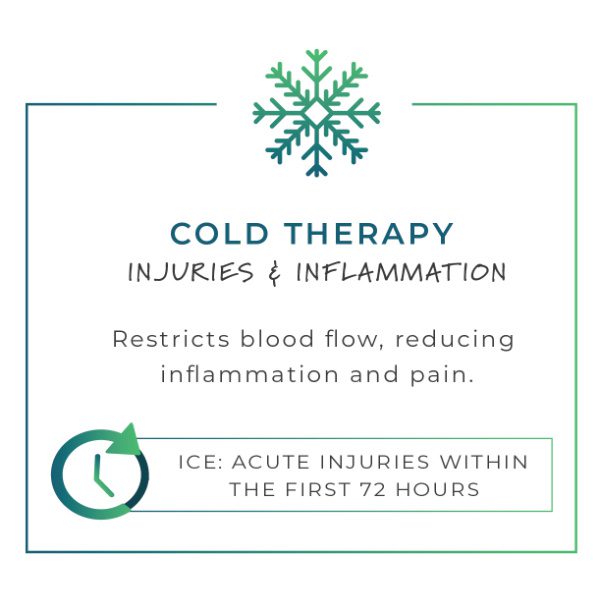
Immediate Treatment: helps prevent the injured area from becoming stiff by reducing tissue fluid.
Rehabilitation: aims to restore normal function to an affected area by reducing pain and spasms, which in turn allows for better movement.
Conditions for Ice Therapy
- Recent Injuries
- Swelling
- Strains & Sprains
- Joint Pain

If you have bad circulation, then cold therapy probably isn’t for you. If you apply ice for too long (or directly!) then skin, tissue or nerve damage becomes a possibility. If you have cardiovascular disease always consult with their doctor before using cold therapy.
Heat Therapy
Usually, heat is the best temperature therapy for relaxing—whereas ice restricts blood vessels, heat opens them, increasing blood flow to an affected area. This is perfect for most aches and pains, and it is also great for repairing damaged tissue since increased blood flow stimulates healing. Minor stiffness and tension can usually be relieved with about 15-20 minutes of heat therapy.
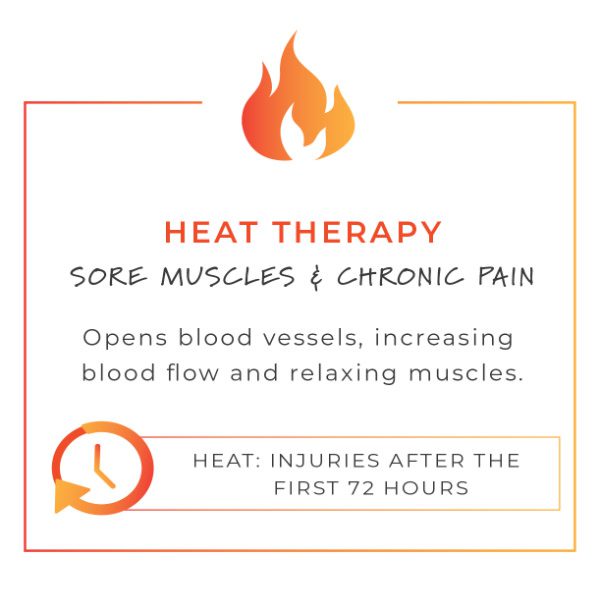
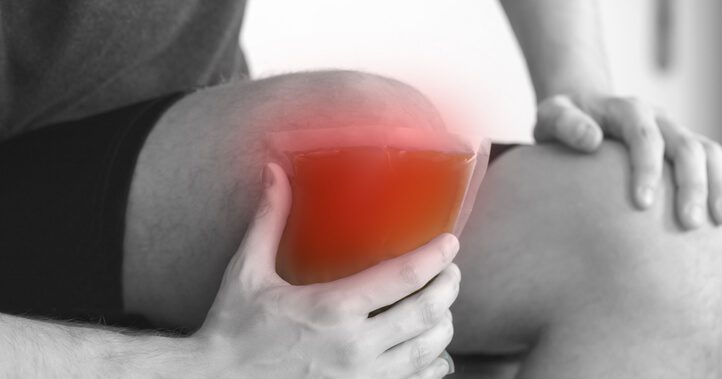
Do not feel the burn! When using heat therapy, you want to keep a nice, even warmth. If you have swelling or bruising, heat isn’t the right call. Never use it near open wounds, and for people with heart disease or hypertension, always ask your doctor before using this treatment.
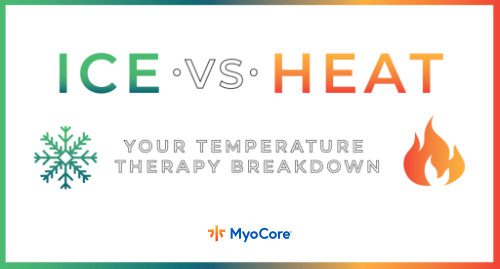
The Complete Heat & Ice Guide
The Ultimate Treatment
When it comes to injuries caused by physical activity, heat or ice therapy can be beneficial, but they are not long-term solutions.
A healthy musculoskeletal system is critical to overall health and healing, affecting how the entire body functions. Chiropractic care can reduce tension and pain and to speed up your recovery time, if an injury happens.
What you need to know about ice and heat therapy for injury care, sore muscles. inflammation and more!
Chiropractic isn’t just for your back! As experts in the musculoskeletal system, our offices specialize in treating extremity conditions to relieve pain and discomfort by improving joint motion, optimizing muscle function, and restoring proper flexibility and strength.
30 Million doctor visits a year are due to knee and shoulder injuries alone.
Common Extremity Issues
- Sciatica
- Arthritis
- Plantar Fasciitis
- Carpal Tunnel Syndrome
- Bursitis
- Tendonitis
- Runner’s Knee
- Bone Spurs
- Muscle Strain
- Shin Splints
- ACL/MCL Injury
- Tennis Elbow
- Torn Rotator Cuff
- Numbing/Tingling
- TMJD
While chiropractors are commonly known to treat spinal issues, we can also help with extremity conditions by using muscle therapy, exercise, and joint adjustments.
Extremity Adjustments
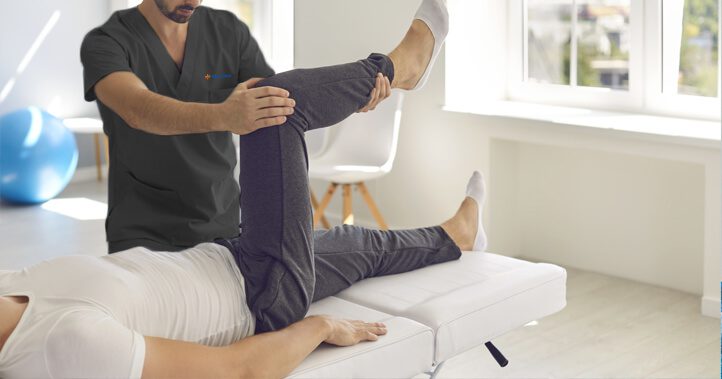
Can restore joint motion to a restricted joint and reduce pain, allowing for proper joint function.
Muscle Therapy
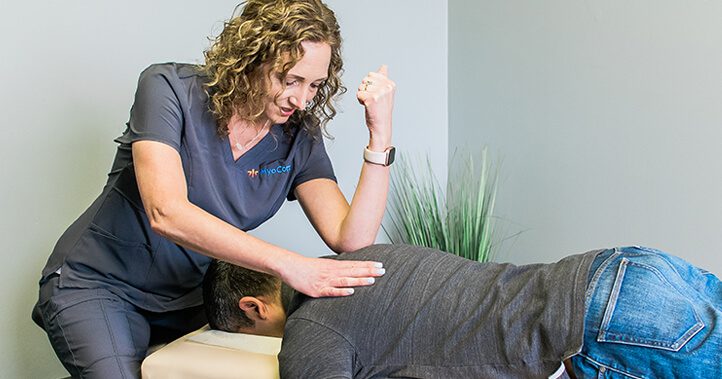
And rehab exercises help to strengthen the muscles around the joint, which can help decrease inflammation and swelling.
Know someone suffering from extremity pain – we’d love to help.
When you refer someone to MyoCore, they’ll receive a $20 Chiropractic Package including a musculoskeletal evaluation, 30-minute myofascial release therapy, and chiropractic adjustment. And as a bonus, you will receive a FREE gift too!

Tips For Joint Health
Stay In Motion – The more you move, the less stiff you’ll be. Change positions and take a 10-minute movement break every hour.
Treat Joint Injuries – Injuries can add to the breakdown of cartilage in your joints. If you get hurt, see your doctor right away for an evaluation.
Strengthen Your Muscles – With proper strength training, you will increase your joints’ stability while decreasing pain.
Drink More Water – Proper hydration can improve the production of synovial fluid, reduce inflammation and maintain the shock-absorbing properties of cartilage.
Omega-3, Vitamin D, & Calcium – Ensure your diet is rich in these crucial nutrients. Omega-3 lowers inflammation and keeps joints healthy. Vitamin D and Calcium are required for healthy bones.
For more tips, download our Free Beyond the Back – Chiropractic & Extremity Care Guide
Chiropractic can help more than just your neck and back! Download this infographic to learn all about how chiropractic care can help with extremity issues like carpal tunnel, sciatica, arthritis and much more.
How Our Chiropractors Use Myofascial Release Therapy to Treat Common Conditions
Living with acute and chronic pain is not only difficult, but it can have a negative impact on your quality of life, emotional state, and stamina to function throughout the day. When a deep ache in your low back or a persistent headache goes from mildly annoying to 100% debilitating, relief quickly becomes both necessary and vital. The good news is that many of these types of common conditions affect the musculoskeletal system, which in turn means they can be resolved with advanced deep tissue treatments, such as Myofascial release (MFR) therapy.
Our chiropractors at MyoCore use MFR therapy to alleviate pain, improve mobility, and optimize your care. They work closely with medical doctors, physical therapists, and other healthcare professionals to provide personalized treatment plans that follow best-in-class protocols. Through an integrated care approach, they are able to better understand their patients’ needs, tailor the right combination of applicable techniques, and perform hands-on, deep tissue treatments that help.
The following information gives a comprehensive understanding of what and how Myofascial release (MFR) therapy can be used to treat common conditions. If you are interested in learning more, find a chiropractor near you that performs MFR.
What is Myofascial Release (MFR) Therapy?
Myofascial release (MFR) therapy is a deep tissue manual therapy technique that focuses on releasing muscular shortness and tightness that cause pain within the body. The technique targets skeletal muscle and connective tissues that are ‘bound’ by tight fascia in the form of adhesions (dense collections of scar tissue) and trigger points (hyperirritable spots that refer pain to other areas of the body). MyoCore specialists use deep, focused manual pressure and stretching to the area to release adhesions and trigger points. This in turn relaxes and restores function to the muscle and its associated joint so that the patient experiences relief and recovery. MFR treatments address the underlying causes of dysfunction and therefore have longer lasting results.
Trigger-point therapy is a form of MFR that applies direct pressure to tense, dense knots of tissue called trigger points. By applying pressure with a finger or other instrument the trigger point eventually “releases” tension and softens so that the area regains its natural function. There are a number of variations on this technique that a skilled practitioner will be able to apply. Some examples include Active Release Technique®, which retrains the muscles’ neurological response pattern so they can relax, and the Graston Technique®.
What Common Conditions Benefit from Chiropractic Treatments Using Myofascial Release (MFR) Therapy?
Since fascia is a connective tissue that runs head to toe in a web-like system, restrictions along its pathway can produce symptoms such as pain, headaches, disease, and dysfunction. The following common conditions can be addressed with safe and effective MFR treatments.
Neck Pain and Headaches
Neck pain is commonly due to postural misalignment, trauma, or inflammation in the soft tissues surrounding the head and neck. Tension within the muscles and tendons can cause localized or referring pain, as well as acute or chronic headaches. MFR can be used to mitigate the pain by reducing the dysfunction of muscle spasms, tightness, and trigger points.
Learn how chiropractic can treat headaches.

Shoulder Pain
Causes of shoulder pain can range from mild to severe as a result of general wear and tear or complete rotary dysfunction. MFR has the ability to address particular areas that are bound and restore pain-free range of motion to the entire shoulder joint.
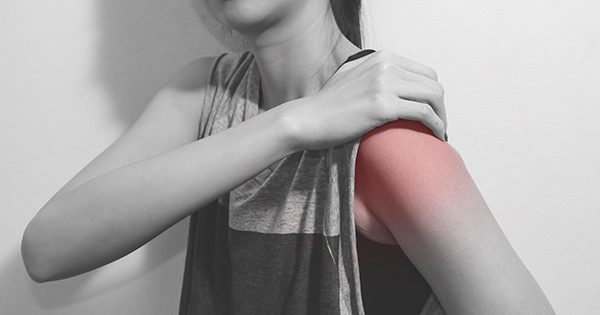
Back and Lower Back Pain
Acute or chronic back pain is a common form of discomfort that can be caused by injury, poor posture, or other habitual physical movements that result in regular wear and tear. By applying MFR to specific areas along the spine and addressing surrounding musculature, back pain can be alleviated or minimized in a manageable way. The goal is restore full function and mobility, which is possible using a variety of MFR techniques.
Learn how chiropractic can treat back pain.
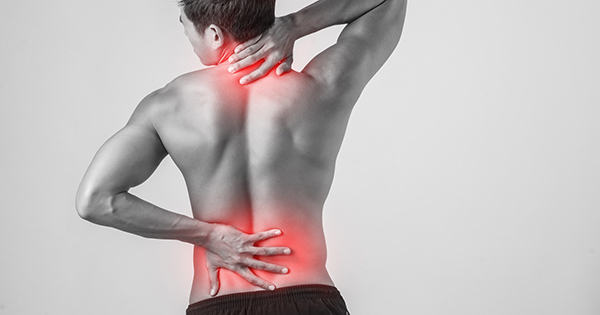
Arm Pain, Leg Pain, and Numb Fingers
Extremity pain typically refers to anything from your arms to fingers and hips to toes (i.e., arms, wrists, fingers, ankles, toes, knees, etc.). MFR applied directly to the affected musculature and to the surrounding areas can help reduce pain, restore function, and improve the associated joint’s range of motion. Specific tools and techniques enable MFR practitioners to work with everything from small to large muscles in an effort to aid in rehabilitation.

Fibromyalgia
Fibromyalgia is a chronic disease that affects the bones and muscles. Myofascial release (MFR) therapy is key to any fibromyalgia treatment because it increases blood and lymphatic circulation, decreases sensitivity, and reduces chronic inflammation.
Learn how chiropractic can treat fibromyalgia.
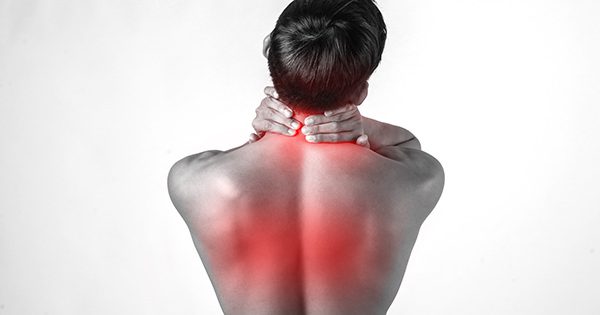
Plantar Fasciitis
Plantar Fasciitis involves inflammation of a thick band of tissue that runs across the bottom of your foot and connects your heel bone to your toes. It can cause limitations and pain in a variety of activities including running, walking, jogging, and hiking. Using MFR along the sole of the foot and into the calf muscles helps reduce pain, increase fascial mobility, and improve joint function.
Learn how chiropractic can treat plantar fasciitis

Treat Common Conditions with MFR
With a commitment to educate, empower, and support our patients, MyoCore works with a team of professionals to offer a variety of MyoFascial release (MFR) therapies that are designed to aid in recovery. We are dedicated to improving the quality of life of every patient through drug-free, noninvasive treatments that relieve pain, improve joint motion, optimize muscle function, and increase flexibility. If you are experiencing any of the above common conditions and are ready to find a chiropractor near you that performs MFR please contact us. We are here to help.
Is Pain Interrupting Your New Year’s Resolution?
The number one most popular New Year’s resolutions made amongst the US population, is to improve health and fitness through exercise. One of the most common reasons this resolution can fail is due to the onset of back pain. Many patients come into our office this time of year with pain that either resulted from injury while exercising, or pain that came on for seemingly no reason and is keeping them from achieving their exercises goals.
One of the most common (and most painful!) conditions we see as a result of beginning an exercise regimen or increasing one’s current exercise program is an increase in or onset of back pain – more specifically sciatica. Sciatica is a broad term that many patients use for any type of pain that radiates into their leg or legs. However, not all sciatica is created equal. Causes of pain radiating into the leg can range from a simple muscle spasm to a herniated disc with compressive neuropathy. Many types of lower back and leg pain can be managed with simple exercises but sometimes it is necessary to see a professional.
Top 3 Stretches For Sciatica Relief
There are several useful exercises you can perform on your own to help resolve the causes of radiating lower back pain and pain into the leg. Here’s our top three!
McKenzie Lumbar Extension

- Begin lying face down on floor or firm surface with elbows bent and hands under shoulders.
- Slowly extend your arms as you press your body upward arching your back and gently squeezing your lower back muscles. Once arms are fully extended, pause momentarily, then slowly lower yourself down to the start position.
- Perform this exercise 10x every hour. STOP this exercise if it seems to worsen your leg pain.
Piriformis Figure 4 Stretch

- Begin lying on your back. Cross one leg over the other, placing ankle on opposite thigh above the knee.
- Grasp uncrossed leg under-thigh and gently pull towards the chest. A stretch in the hip of the crossed leg should be felt. Hold for 20-30 seconds and repeat for prescribed repetitions.
- Perform this stretch 2-3 times per day on the affected side
Psoas Stretch

- Start in a lunge with the back knee down.
- Keeping your back straight, shift your hips forward until you feel a stretch.
- Hold the stretch for 20 to 30 seconds.
- Switch legs and repeat until you feel adequately stretched.
When To See A Professional
If pain persists despite trying these exercises or you develop numbness, tingling, or weakness, then it is time to see a professional. There could be a more significant issue causing the pain, or you just may need additional muscle work, stretches, and exercises outside of what you can do on your own.
If pain is keeping you from reaching your 2021 goals, schedule an appointment at one of our offices today!
Find out how to empower, engage and act towards improving the quality of your overall health with chiropractic care and techniques.
Anyone who has heard the word “stress” can tell you that it is incredibly common. A recent survey revealed that nearly 80 percent of Americans experience stress, with 44 percent encountering it frequently in their daily lives. While stress is a normal part of life, it can negatively impact your relationships, your career, and even your physical well-being if it becomes chronic. But here is some good news – you can take control of your stress level with chiropractic care before it takes control of you.
What Exactly is Stress and How is it Identified?
Simply put, stress is the body’s response to pressure from certain events or situations, and can be triggered by any number of factors including personal relationship issues, financial worries, career troubles, or health concerns.
While stress can generate a number of reactions, physical manifestations are overwhelmingly common, and knowing the signs is one of the most crucial steps in successful stress management. A study by the American Institute of Stress revealed that 77 percent of people who identify as being stressed reported physical symptoms such as:
- Chronic pain
- Muscle tension
- Headaches
- Digestive issues
- Elevated blood pressure
- Disturbed sleep cycle
- Chest pain
- Rapid heartbeat
How Chiropractic Care Helps
Chiropractic treatment can interrupt the cycle of stress, tension, and pain by treating the cause of pain as well as activating the parasympathetic system, which calms the “fight or flight” reaction that commonly occurs during stressful situations. Research suggests that receiving regular chiropractic adjustments and muscle therapy such as myofascial release can have a number of benefits that may help your body fight against prolonged chronic stress, including:
- Easing muscle tension
- Reducing pain
- Soothing irritated nerves
- Improving sleep
You Play a Role Too
You can manage your stress in several ways that are not only healthy, but also provide an excellent complement to your chiropractic care. These include:
- Having a healthy diet rich in healthy fats (avocado, nuts, and seeds), antioxidants (dark berries and leafy greens), and omega-3 fatty acids (fish)
- Exercising for 30 minutes three days per week
- Relaxation techniques such as yoga or meditation
- Getting 7-9 hours of quality sleep each night
- Maintaining personal connections and a strong, healthy support system to keep you encouraged and motivated
As an additional benefit, these changes are easy to implement and can be done right in your home so you can get on the path to stress reduction today.
Anyone who has had back pain knows it can be disruptive, especially since it is the leading cause of disability worldwide. It is also the second leading cause for doctor visits behind only upper-respiratory infections and can become chronic or even debilitating without the right treatment. MyoCore takes these facts and more into consideration through integrated care, a unique approach that involves frequent close coordination between chiropractors, physicians and other medical professionals to provide patients with a high level of care that addresses pain at the source.
What is Integrated Care?
Many other medical disciplines employ cooperation between any number of doctors, nurses and other healthcare specialists in order to determine the root cause of a patient’s condition and formulate a treatment plan that optimizes the chances for a successful outcome. Chiropractic care is no different, as it requires that same level of coordination to properly treat pain. And that is one of the core principles of MyoCore’s integrated care model.
At MyoCore, our integrated care model refers to the collaboration between our chiropractors, and physicians or other healthcare providers who work together to design personalized treatment plans that meet your specific needs. If you’re having musculoskeletal pain that can be addressed without an invasive procedure, your physician may refer you to a MyoCore chiropractor. Similarly, if your condition isn’t within the scope of chiropractic care, MyoCore chiropractors will refer you to the proper physician or other healthcare provider to get the treatment you need.
When combined with evidence-based care and following best-in-class protocols, integrated care provides therapeutically effective treatment and patient support dedicated to achieving satisfaction.
How Can You Benefit From Integrated Care?
When your physician and chiropractor work together, you aren’t just getting drug-free treatment for your pain. You’re benefitting from a comprehensive and conservative approach that addresses your complete needs and goals as a patient. That’s why integrated care can produce results that may equal or even surpass those of physiotherapy, chiropractic, or drug therapy alone.
And the best part? Everything is designed for you right there in the hospital so you can get started on your journey toward better function and reduced pain right away.
Find out more about how chiropractic care can help you live a healthier lifestyle so you can be better prepared for cold and flu season with this infographic.